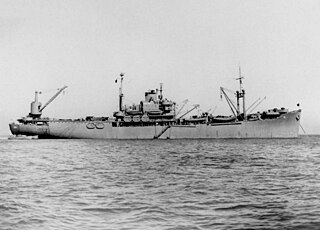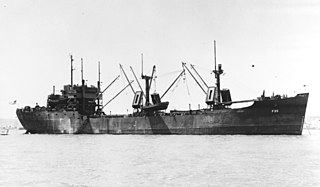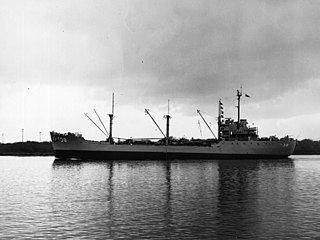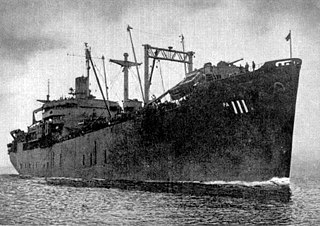
USS Terror (CM-5) was a fleet minelayer of the United States Navy, the only minelayer of the fleet built specifically for and retained for minelaying during World War II.

USS Venango (AKA-82) was a Tolland-class attack cargo ship in service with the United States Navy from 1945 to 1946. She was sold into commercial service and was scrapped in 1971.

USS Haskell (APA-117) was the lead ship of her class of attack transports, built for the United States Navy during World War II. She was of the VC2-S-AP5 Victory ship design type. Haskell was named for the Haskell Counties of Kansas, Oklahoma, and Texas.

USS Arenac (APA-128) was a Haskell-class attack transport in service with the United States Navy from 1945 to 1946. She was scrapped in 1974.

USS Salem (CM-11) was a commercial cargo ship, that served as a minelayer and then net laying ship of the United States Navy during World War II.

USS Pocomoke (AV-9) was a Pocomoke-class seaplane tender, originally built as the SS Exchequer and acquired by the U.S. Navy as the military build-up occurred in the United States just prior to World War II. She operated principally in the Pacific Theatre of the war and serviced military seaplanes. At war’s end, she returned to the United States with two battle stars.

USS LST-19 was a United States Navy LST-1-class tank landing ship used exclusively in the Asiatic-Pacific Theater during World War II and manned by a United States Coast Guard crew. Like many of her class, she was not named and is properly referred to by her hull designation.
USS Atascosa (AO-66) was an Atascosa-class fleet oiler acquired by the U.S. Navy for use in World War II. She had the dangerous task of supplying fuel and ammunition to ships in and near, combat areas in both the Atlantic Ocean and the Pacific Ocean.
USS Zaurak (AK-117) was a Crater-class cargo ship commissioned by the U.S. Navy for service in World War II. She was responsible for delivering troops, goods and equipment to locations in the war zone.

USS Ara (AK-136) was a Crater-class cargo ship commissioned by the US Navy for service in World War II. Ara is named after the constellation Ara. She was responsible for delivering troops, goods and equipment to locations in the Asiatic-Pacific Theater.

USS Adria (AF-30) was an Adria-class stores ship in service with the United States Navy from 1944 to 1954. She was scrapped in 1977.

USS Corduba (AF-32) was an Adria class stores ship in service with the United States Navy from 1945 to 1955. She was scrapped in 1974.

USS Karin (AF-33) was an Adria stores ship in service with the United States Navy from 1945 to 1958. She was into commercial service in 1969 and was scrapped in 1987.

USS Kerstin (AF-34) was an Adria class stores ship in service with the United States Navy from 1945 to 1950.

USS Latona (AF-35) was an Adria-class stores ship in service with the United States Navy from 1945 to 1949. She was scrapped in 1973.

USS Merapi (AF-38) was an Adria stores ship acquired by the U.S. Navy for service in World War II, named after Mount Merapi, the mountain in Java, Indonesia. Her task was to carry stores, refrigerated items, and equipment to ships in the fleet, and to remote stations and staging areas.

USS Athanasia (AF-41) was an Adria-class stores ship in service with the United States Navy in 1945. She was sold into commercial service in 1977.

USS Valentine (AF-47) was an Adria-class stores ship in service with the United States Navy from 1945 to 1946 and from 1951 to 1959. In 1967, She was sold into commercial service and she was scrapped in 1987.
USS Wautauga (AOG-22) was a Mettawee-class gasoline tanker of the United States Navy during World War II.

USS Grundy (APA-111) was a Windsor-class attack transport that served with the United States Navy from 1945 to 1946. She was subsequently sold in to commercial service and was scrapped in 1973.

















